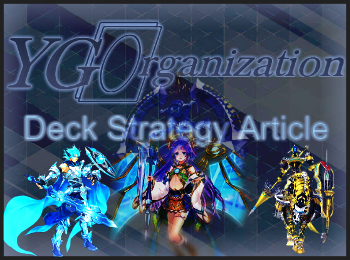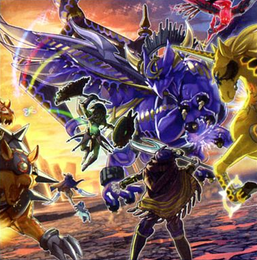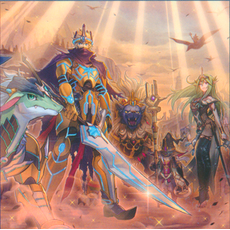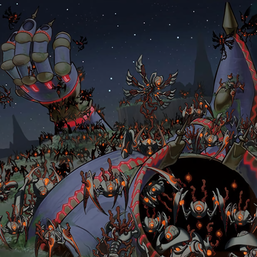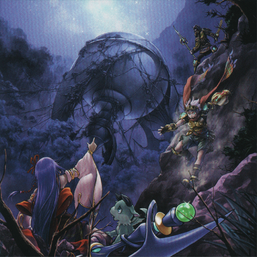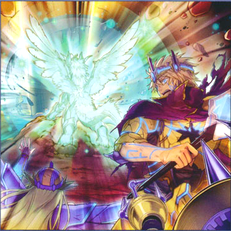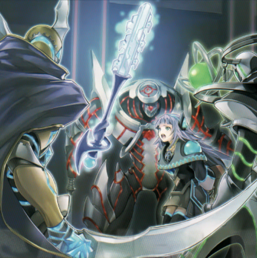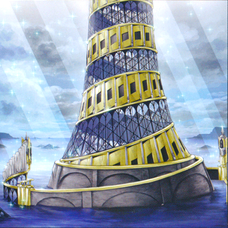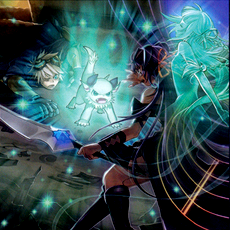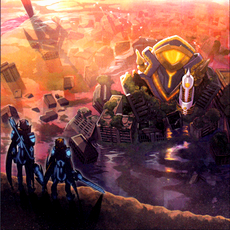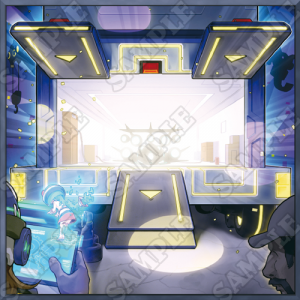Dare to be unpredictable, combining the strength of all the World Legacy archetypes and forge onward in the quest for true power.
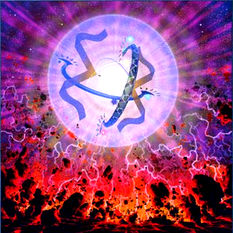
If You’re Here for the Lore…
The current series of World Legacy archetypes, connected through artwork, lore, and effect references, is one of the greatest tapestries that this game has seen in terms of all three categories. While we don’t have an official synopsis of all the lore going into this archetype, we have pieces. If you’re interested in the lore, I suggest that you check out this awesome summary on the Yugioh Subreddit; it covers everything better than I could write in this strategy article. So without further ado, let’s get into the individual archetype strategies so we can dive into the big mashup.
We will start with the bread and butter of the Link Summoning mechanic – the Knightmare archetype. This archetype is super generic and is known for being the toolbox of Link monsters in the VRAINS era, but since each of the monsters also benefits from being Co-Linked, you can use their toolboxing abilities to eliminate threats without losing hand presence. While we have gained a couple of Main Deck Knightmares so far, such as Knightmare Corruptor Iblee, this theme hasn’t been played pure for the simple reason that it needs a core of monsters that can easily establish a field presence and continue spamming more and more link material onto the field.
With the largest sustained impact on the meta as a standalone strategy, the Crusadia is the OTK archetype of the World Legacy themes. Two Crusadia monsters can start an endless chain, building up a set of summons that lead one, into the next, into the next, all the while searching other pieces of the OTK. Due to Crusadia Magius having an arrow pointing straight down, this opens up a significant amount of combo potential with the Knightmare archetype, since the two monsters that want to be Co-Linked the most happen to point straight up. The other defining trait of the Crusadia is that the Link monsters want you Special Summoning to the zone they point to, which will become more relevant later.
Next on our list is the Krawler archetype, known as the one who doesn’t play as well with the others. This OTK archetype can be seen as a mix of the two previous ones, because you want to get as many Krawler monsters linked together on the field to create the conditions for an OTK. Despite each of the Main Deck Krawlers having the ability to spam the field with two others when it leaves the field due to an opponent’s card effect, the archetype alone just cannot provide enough fodder sometimes to make these OTK fields as consistently. But where the Krawler may lack in streamlined combos, all of their support cards are built to greatly support other World Legacy themes. This is especially apparent with Crusadia Krawler, a trap monster that supports the World Legacy archetype despite being in both this and the previous World Legacy theme.
The original World Legacy archetype, this is the first to feature Normal Monsters as they set off on a quest to gain the power of the fabled World Legacy relics. As the first game-original archetype to showcase the Link Summoning mechanic, it differs from the previous Link themes as wanting to build chains of Link Summons together, using previously summoned monsters as fodder for the next Link Summon. This archetype also features the first crossover monster between a World Legacy theme and the World Legacy archetype itself in the powerful World Legacy – “World Chalice”. The theme also introduced the World Legacy’s first ‘hand-trap’ in World Chalice Guardragon, which protects a linked monster from a targeted effect. But speaking of Dragons…
Next up on our tour of the World Legacy themes is the Guardragon, the combo theme that makes best use of existing support cards. With the ability to Special Summon any Dragon from the Main Deck, Hand, GY, Banished pile, or Deck through their arsenal of Link Monsters, this theme runs opposite to the previous Link themes as you need to summon to empty zones that multiple Link monsters point to. This pairs nicely with the Crusadia, as you can trigger both of their effects with the right setups. But the Guardragon also mesh well with the World Chalice monsters, not only having a monster in both archetypes, but also since the Guardragon revolve around Normal Monsters as well! So you should already start to see more connections being drawn between the themes.
But don’t get too far ahead of yourselves, as we have the Psychic theme approaching the fray. The Mekk-Knight archetype features powerful monsters that can Special Summon themselves from the hand if multiple cards are in the same column. So for example, if you had a Crusadia Magius and a set Spell/Trap in its column, you could summon any of the Mekk-Knights, triggering the effect of your Magius. The Mekk-Knight theme also offers great search power, as they have three separate monsters that carry the ability to search another Mekk-Knight from the deck, keeping the flood of monsters going right onto your field.
This leaves us with our final World Legacy theme before we get to discussing the World Legacy archetype itself, and we saved the most restricted for last – the Orcust. These DARK/Machine musical instruments combine extremely simple effects into a never ending chain of monsters hitting the field, being turned into Link monsters, then being banished to continue the chain. However, you are restricted to Special Summoning only DARK monsters after activating one of their effects. To top it all off, their Link monsters return banished Machines to the deck to gain more advantage or control over the duel. Simply by activating their Field Spell, Orcustrated Babel, the archetype reaches a crescendo of power because each of their effects become quick effects while it is on the field. This theme also shares a dual-archetyped monster, as Orcust Knightmare is yet another name for Knightmare Mermaid to Special Summon from the deck.
The World Legacy:
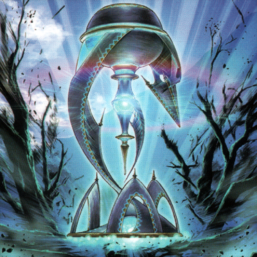 So each of these themes may have a similar concept of establishing a field presence and turning that presence into Link monsters to gain a foothold over the duel and to work towards its individual win condition. But I would be remiss to mention any of these themes in a vacuum, since they all are tied together by the World Legacy archetype. Many of the support cards for these individual themes are all part of the World Legacy archetype, despite directly supporting a World Legacy theme. Take for example, World Legacy’s Mind Meld, a trap that directly supports the Krawler or World Legacy’s Heart, a spell that directly supports the World Chalice. This synergy also goes the opposite direction, as some themed cards also support the World Legacy theme. Examples of this phenomenon include Orcustrated Return or Crusadia Vanguard that work with both Orucst and World Legacy monsters or Crusadia and World Legacy monsters respectively. This creates an inherent synergy between the World Legacy archetype and each of its themes.
So each of these themes may have a similar concept of establishing a field presence and turning that presence into Link monsters to gain a foothold over the duel and to work towards its individual win condition. But I would be remiss to mention any of these themes in a vacuum, since they all are tied together by the World Legacy archetype. Many of the support cards for these individual themes are all part of the World Legacy archetype, despite directly supporting a World Legacy theme. Take for example, World Legacy’s Mind Meld, a trap that directly supports the Krawler or World Legacy’s Heart, a spell that directly supports the World Chalice. This synergy also goes the opposite direction, as some themed cards also support the World Legacy theme. Examples of this phenomenon include Orcustrated Return or Crusadia Vanguard that work with both Orucst and World Legacy monsters or Crusadia and World Legacy monsters respectively. This creates an inherent synergy between the World Legacy archetype and each of its themes.
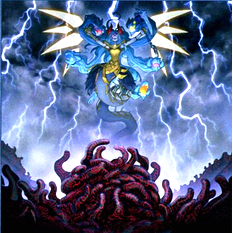 But the World Legacy archetype also stands alone in the crowd as its own archetype of DARK Machines that counter monsters summoned from the Extra Deck. World Legacy – “World Crown” may share a similar Special Summon effect to those of the Crusadia theme, but it also can tribute itself to negate the activation of an effect of a monster summoned from the Extra Deck. These relics also include effects that support Tribute Summoning in particular, as some of them gain effects when Normal or Tribute Summoned that they otherwise would not have access to. So how does this archetype hold together a bunch of Link themes with such an anti-Extra Deck core mechanic? Well it doesn’t – AND it shouldn’t. Remember the last major archetype experiment was the Zefra, which integrated 5 different archetypes into the Zefra theme at the end, but that card design was about supporting every single theme with one archetype. In the case of the World Legacy, it is the exact opposite – all of the individual themes support the World Legacy AND each other to the point where a cohesive strategy built around Link Summoning can emerge.
But the World Legacy archetype also stands alone in the crowd as its own archetype of DARK Machines that counter monsters summoned from the Extra Deck. World Legacy – “World Crown” may share a similar Special Summon effect to those of the Crusadia theme, but it also can tribute itself to negate the activation of an effect of a monster summoned from the Extra Deck. These relics also include effects that support Tribute Summoning in particular, as some of them gain effects when Normal or Tribute Summoned that they otherwise would not have access to. So how does this archetype hold together a bunch of Link themes with such an anti-Extra Deck core mechanic? Well it doesn’t – AND it shouldn’t. Remember the last major archetype experiment was the Zefra, which integrated 5 different archetypes into the Zefra theme at the end, but that card design was about supporting every single theme with one archetype. In the case of the World Legacy, it is the exact opposite – all of the individual themes support the World Legacy AND each other to the point where a cohesive strategy built around Link Summoning can emerge.
Seriously? Making a Lore Deck just for the sake of it?
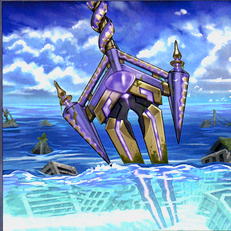 I’m sure many of you are asking the question, why try to integrate so many archetypes together when smaller combinations have already been proven to work. World Chalice Guardragon, Crusadia Guardragon, Crusadia Mekk-Knight, pure Crusadia, Orcust, pure World Chalice, the Knightmare Toolbox… all of these are strategies that have had a chance to shine on the competitive scene since the beginning of the Link era. But by combining each of the themes now that they have been released, you can truly take the strengths of all of these archetypes to create a variant that can be better than the sum of its parts in some regards. Since each of these themes relies heavily on Link monsters, each individual archetype contributes many extenders that can be played to keep things going. Unlike a Crusadia deck that falters after losing the initial Normal Summon, or a Guardragon deck that fails to begin a combo after an Elpy is hit by a Ghost Ogre & Snow Rabbit, a combination of all of these archetypes will typically have options to keep going. This strategy also gives so many options, offering disruption, OTK power, combo potential, lock combos, blanket negation and more, just for running a diverse deck build. Well if I haven’t lost you yet, please bear with me through the decklist and the explanation of coming up with the specific ratios before you simply move along.
I’m sure many of you are asking the question, why try to integrate so many archetypes together when smaller combinations have already been proven to work. World Chalice Guardragon, Crusadia Guardragon, Crusadia Mekk-Knight, pure Crusadia, Orcust, pure World Chalice, the Knightmare Toolbox… all of these are strategies that have had a chance to shine on the competitive scene since the beginning of the Link era. But by combining each of the themes now that they have been released, you can truly take the strengths of all of these archetypes to create a variant that can be better than the sum of its parts in some regards. Since each of these themes relies heavily on Link monsters, each individual archetype contributes many extenders that can be played to keep things going. Unlike a Crusadia deck that falters after losing the initial Normal Summon, or a Guardragon deck that fails to begin a combo after an Elpy is hit by a Ghost Ogre & Snow Rabbit, a combination of all of these archetypes will typically have options to keep going. This strategy also gives so many options, offering disruption, OTK power, combo potential, lock combos, blanket negation and more, just for running a diverse deck build. Well if I haven’t lost you yet, please bear with me through the decklist and the explanation of coming up with the specific ratios before you simply move along.
Decklist:
Monsters (24):
| Astro Knightmare Idlee
| Crusadia Arboria
|| Crusadia Draco
| Deus X-Krawler
| Guardragon Garmides
| Guardragon Justicia
| Knightmare Corruptor Iblee
| Mekk-Knight Blue Sky
| Mekk-Knight Indigo Eclipse
|| Mekk-Knight Purple Nightfall
| Orcust Cymbal Skeleton
| Orcust Harp Horror
| Orucst Knightmare
| World Chalice Guardragon
| Chosen by the World Chalice
| World Legacy – “World Armor”
|| World Legacy – “World Chalice”
| World Legacy – “World Crown”
| World Legacy – “World Lance”
| World Legacy – “World Wand”
| Mardark the World Legacy GuardragonSpells (11):
| Foolish Burial
| Guardragon’s Reincarnation
|| Orcustrated Return
| World Legacy Beginning
| World Legacy Guardragon
|| World Legacy Succession
|| World Legacy Survivor
| World Legacy’s CorruptionTraps (6):
||| Crusadia Krawler
| Crusadia Vanguard
| Orcustrated Climax
| World Legacy’s Mind MeldExtra Deck:
| Almarduk the World Chalice Guardragon
| Ib the World Chalice Miko
| Dingirsu, Orcust of Sheol
| Crusadia Magius
| Crusadia Regulex
| Galatea, the Orcust Automaton
| Guardragon Elpy
| Knightmare Cerberus
| Knightmare Mermaid
| Knightmare Phoenix
| Longirsu, the Orcust Orchestrator
| Mekk-Knight Crusadia Astram
| Mekk-Knight of the Morning Star
| Triple Burst Dragon
| World Source Regalia Demiurgear
How did I come up with this list?
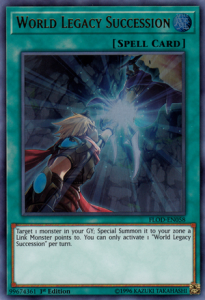 Let me begin with this – this deck is not as haphazard of a creation as you might think after just reading the deck. This build in particular is quite calculated on a couple of metrics that I hold most important when determining a deck build. First, the Normal Summon. Since by game mechanics we are limited to 1 Normal Summon, we want to ensure we never have too many cards that want to be Normal Summoned but also enough to make use of the mechanic. In this build, we want to normal: any of the Crusadia, Knightmare Iblee, and the World Chalice. This makes 5 monsters that we absolutely want to use our initial summon for, so we are not overdoing it on that front. While we can use the normal on other things, such as on an Orcust Harp or a Justicia, the point of this is to only leave backup plans in case things go wrong, because we don’t need to rely on anything else to get the most of the cards. Another criteria is our extenders – we want to ensure we can keep plays going even if something at the beginning gets interupted. Between the Mekk-Knights summoning themselves from hand, the Crusadia summoning themselves to an open zone a Link Monster points to, some of the World Legacies being able to be Special Summoned from hand, both effects of World Wand, the Orcusts, and World Legacy Succession we are also good on that front. In fact, we have great extended plays once we have an established hand, field or GY. So that leads into the next criteria – how can we setup?
Let me begin with this – this deck is not as haphazard of a creation as you might think after just reading the deck. This build in particular is quite calculated on a couple of metrics that I hold most important when determining a deck build. First, the Normal Summon. Since by game mechanics we are limited to 1 Normal Summon, we want to ensure we never have too many cards that want to be Normal Summoned but also enough to make use of the mechanic. In this build, we want to normal: any of the Crusadia, Knightmare Iblee, and the World Chalice. This makes 5 monsters that we absolutely want to use our initial summon for, so we are not overdoing it on that front. While we can use the normal on other things, such as on an Orcust Harp or a Justicia, the point of this is to only leave backup plans in case things go wrong, because we don’t need to rely on anything else to get the most of the cards. Another criteria is our extenders – we want to ensure we can keep plays going even if something at the beginning gets interupted. Between the Mekk-Knights summoning themselves from hand, the Crusadia summoning themselves to an open zone a Link Monster points to, some of the World Legacies being able to be Special Summoned from hand, both effects of World Wand, the Orcusts, and World Legacy Succession we are also good on that front. In fact, we have great extended plays once we have an established hand, field or GY. So that leads into the next criteria – how can we setup?
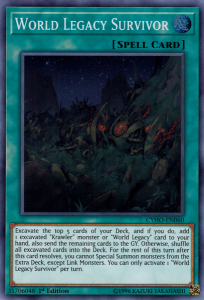 In this build, I choose to rely heavily upon Crusadia Krawler as the best setup card. Yes, it is trap and inherently slow. But it also provides a body that can be turned into a Crusadia Magius or Crusadia Regulex, a Level 2 monster to pair with Chosen of the World Chalice to become the World Chalice Synchro, and recyclable discard fodder with the help of Crusadia Draco. In fact, this is the only card in the whole decklist I run at 3, since it is so versatile. If it is summoned to a zone, you can search out extenders, combo starters, disruption, and more, since “World Legacy” cards offer so much diversity in their effects. The other main starter for the deck is World Legacy Survivor, as it sends the top 5 cards of your deck to the GY and lets you add a World Legacy card among them to the hand. With so many cards offering effects from the GY (11), cards that can make use of others in the GY, and just the power of deck thinning, this is always a great choice. The one downside to Survivor is that it locks you into only Link Summoning for the rest of the turn, so that prevents plays into the World Chalice Synchro, the Guardragon Fusion, or the Orcust Xyz. Therefore, we have starters, we have extenders, we have no over-reliance on the Normal Summon, so what about the individual balance of each theme?
In this build, I choose to rely heavily upon Crusadia Krawler as the best setup card. Yes, it is trap and inherently slow. But it also provides a body that can be turned into a Crusadia Magius or Crusadia Regulex, a Level 2 monster to pair with Chosen of the World Chalice to become the World Chalice Synchro, and recyclable discard fodder with the help of Crusadia Draco. In fact, this is the only card in the whole decklist I run at 3, since it is so versatile. If it is summoned to a zone, you can search out extenders, combo starters, disruption, and more, since “World Legacy” cards offer so much diversity in their effects. The other main starter for the deck is World Legacy Survivor, as it sends the top 5 cards of your deck to the GY and lets you add a World Legacy card among them to the hand. With so many cards offering effects from the GY (11), cards that can make use of others in the GY, and just the power of deck thinning, this is always a great choice. The one downside to Survivor is that it locks you into only Link Summoning for the rest of the turn, so that prevents plays into the World Chalice Synchro, the Guardragon Fusion, or the Orcust Xyz. Therefore, we have starters, we have extenders, we have no over-reliance on the Normal Summon, so what about the individual balance of each theme?
- Extra Deck Composition – This is the most difficult part of building this deck, but I started by giving each theme 2 slots in the Extra to play with, then adjusted from there. Will describe in each section below.
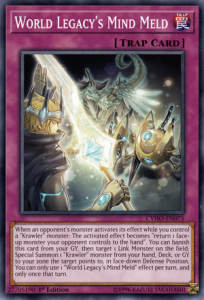 Krawler – The worst theme at playing with the others, but Deus offers blanket negation and Mind Meld lets you summon it from anywhere. Also, the Crusadia Krawler playset is the versatile starter I already mentioned. Since we aren’t running more Krawler, there is no need to add any to the Extra.
Krawler – The worst theme at playing with the others, but Deus offers blanket negation and Mind Meld lets you summon it from anywhere. Also, the Crusadia Krawler playset is the versatile starter I already mentioned. Since we aren’t running more Krawler, there is no need to add any to the Extra.- World Chalice – The World Chalice itself serves a dual purpose as a searcher and Link combo machine, so this is an awesome card to run at multiple copies. To use its second effect however, you have to have 2 other WC monsters, so that is why Chosen and Guardragon made the cut. Chosen is due to the level synergy with both Crusadia Krawler and Justicia (to make the Level 5 synchro), and Guardragon is due to its protection effect and its extender nature. In terms of the Extra, the two slots for WC went towards the Synchro and the Fusion.
- Knightmare – Due to the ability of Mermaid to pull any Knightmare from the deck, it makes sense to run one of each to provide the utility, not to mention how awesome Orcust Knightmare is a starter for the Orcust portion of the deck. I’ve taken 3 of the Extra spots for Cerb, Phoenix, and Mermaid for the simple reason that space is tight and these are the best ways to start off your combos to eliminate threats before throwing too many cards into something like a Unicorn. *Note: Unicorn was a last minute drop I explain in the Guard section.
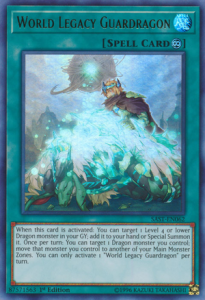 Mekk-Knight – This is, to be blunt, an archetype of extenders, so we want to maximize these as much as possible. I’m running these specific 4 for a reason – first, Purple is the best to get first since it lets you get the others to your hand (read as: Get Blue Sky). Then, when you summon Blue Sky, you want to have 2 names left in deck which is why having an Indigo to round things out is great. In terms of the Extra, their slots go to Morning Star (for the World Legacy card search) and Astram because it is just so amazing. This card wins so many duels, it is insane.
Mekk-Knight – This is, to be blunt, an archetype of extenders, so we want to maximize these as much as possible. I’m running these specific 4 for a reason – first, Purple is the best to get first since it lets you get the others to your hand (read as: Get Blue Sky). Then, when you summon Blue Sky, you want to have 2 names left in deck which is why having an Indigo to round things out is great. In terms of the Extra, their slots go to Morning Star (for the World Legacy card search) and Astram because it is just so amazing. This card wins so many duels, it is insane.- Crusadia – As starters, it is great to have this combination. Draco is the best Crusadia monster, since it can add back either Krawler or another Crusadia when summoned to continue the spam train, but it is also a Dragon to synergize with the Guardragons. Arboria is the second choice for another Crusadia name, since it is the only one that isn’t solely OTK-focused. Then Vanguard is included to let you trade your monsters for a “World Armor” for a search or the others for disruption. For the Extra, Magius and Regulex are the clear shoe-ins due to the search power.
- Orcust – The Orcust monster chain is practically mandatory, but you don’t need to run Brass since it is unlikely you will have an Orcust in hand. As far as support cards are concerned, Orcustrated Return digs through the deck quicker and can trigger “World Wand” and prime “World Chalice”‘s GY eff, and Orcustrated Climax is a great disruption tool to search with Galatea. Longirsu fills the second Orcust ED slot, since it provides monster removal and a Link 3 to climb off of Galatea. Then we include Sheorcust over one of the World Legacy slots to provide protection and non-targeting, non-destruction monster removal.
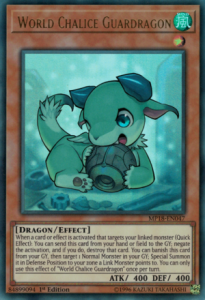 Guardragon – First, Mardark the World Legacy Guardragon is a searchable Level 9, making his inclusion mandatory (explained in more detail as a win condition). Then, we need an additional Normal monster to unlock his summon from hand, so Justicia is better than another World Chalice since it is a Dragon tuner. Garmadies allows you to get a World Chalice Guardragon to the GY, as well as being a killer extender in “World Chalice” combos. As for the Extra, Elpy lets you grab so many different dragons (like Draco, Mardark, Justicia, etc.), and then you need a higher Link Dragon to summon afterwards to remove Elpy’s restriction on summoning only dragons, which is why Triple Burst Dragon is used here over Unicorn.
Guardragon – First, Mardark the World Legacy Guardragon is a searchable Level 9, making his inclusion mandatory (explained in more detail as a win condition). Then, we need an additional Normal monster to unlock his summon from hand, so Justicia is better than another World Chalice since it is a Dragon tuner. Garmadies allows you to get a World Chalice Guardragon to the GY, as well as being a killer extender in “World Chalice” combos. As for the Extra, Elpy lets you grab so many different dragons (like Draco, Mardark, Justicia, etc.), and then you need a higher Link Dragon to summon afterwards to remove Elpy’s restriction on summoning only dragons, which is why Triple Burst Dragon is used here over Unicorn.- World Legacy – Only the essential World Legacies are used here, Armor for the search, Chalice for the combo and search, Crown for the extender and disruption, Wand for the Orcust summon, and Lance to provide protection for your Links (or generate extra Link fodder in a pinch, to then run over with Triple Burst for piercing damage). Survivor is the setup WL card, Guardragon is the spell that combos with both Crusadia and the Guardragons, letting you go into Elpy combos as needed, and Succession/Corruption act as extenders. The final Extra deck slot goes to Demiurgear as a win condition for the deck.
Convinced that this is not a random mashup of cards yet? Either way, here is a showcase the combo potential of this deck through a handful of example duels. I’ve included a ton below to provide a better picture of how this monstrosity functions.
Test Duel Logs:
To some of you, that build seems like everything but the kitchen sink; how can it actually work together? Below is a set of many examples from real test duels. Note that some cards in the test duels below are not included in the final list, as the build for this deck (especially in the limited Extra Deck) has been in constant flux to end on the build you see here today. For example, Crusadia Equimax appears in a couple of the duels, when it was originally included over Almarduk.
Duel 1 – Witchcraft:
Spoiler
Going 1st, opening Hand: World Legacy Survivor, Crusadia Vanguard, Crusadia Krawler, World Legacy’s Mind Meld, & Guardragon Justicia- Activated WL Survivor, milling Crusadia Krawler, World Legacy’s Corruption, Knightmare Corruptor Iblee, World Legacy Guardragon, and World Legacy – “World Chalice”, then decided to add WL Guardragon to hand.
- Set Vanguard, Krawler, and Justicia, then ended my turn on a passive note
Opponent began their turn, Summoning Witchfraft Schmitta, then moving to BP and attacking my set Justicia. In MP2, they used Spellbook of Knowledge on Schmitta, drawing 2. Next came Schmitta’s eff, sending Witchcraft Scroll to the GY. Then they set 1 and ended.
Began my turn and drew World Legacy – “World Wand”.
- Used “World Chalice” in GY, to add another copy of “World Chalice” to the hand.
- Tributed Summoned “World Chalice” using Justicia, then activated WL Guardragon to bring Justicia right back to the field.
- Link Summoned Knightmare Phoenix, activating “World Chalice” as CL1, then Phoenix as CL2, discarding Mind Meld. I destroyed their set card, then summoned World Chalice Guardragon and Chosen by the World Chalice.
- Link Summoned Knightmare Mermaid with Phoenix, then by discarding “World Wand”, I summoned Astro Knightmare Idlee to the field.
- Activated my set Krawler, summoning it to the empty zone Mermaid points to, which triggered its effect to add World Legacy Beginning to hand.
- Link Summoned Crusadia Regulex with Krawler and Mermaid, then activated Beginning on Idlee, which allowed me to Special Summon Deus X-Krawler and Mardark the World Legacy Guardragon from deck. This then triggered Regulex, which added another Crusadia Krawler to hand.
- Link Summoned Triple Burst Dragon with Regulex and Crusadia Krawler, then used WC Guardragon’s eff in GY to Special Summon Jusicia back to the open zone burst pointed to.
- Synchro Summoned Ib the World Chalice Miko using Chosen by the WC and Justicia. Its effect triggered on summon, adding World Legacy Succession to hand.
- Link Summoned World Regalia Demiurgear using Ib, Mardark, and Deus-X, which triggered Ib’s effect, summoning “World Chalice” back to the field from my GY.
- Used WL Succession on Mardark, then attacked for game with all 4 of my monsters (Astro, Regalia, Triple, and Mardark).
Duel 2 – PSY-Frame
Spoiler
Going 1st, opening Hand: World Legacy Beginning, Mekk-Knight Indigo Eclipse, World Legacy Succession, Orcust Knightmare, Crusadia KrawlerI set Krawler and ended.
My opponent drew for his turn, then summoned Phantom Skyblaster, made a Token, then Link Summoned Link Spider using the Token. Next, they used both monsters to Link Summon PSY-Framelord Lambda, attacked directly, set a card to the backrow, then ended.
Began my turn drawing Crusadia Draco. I Set Beginning to the same column as Lamdba, then inherently Special Summoned Indigo Eclipse to that column. Since my opponent had no response, I attacked over Lamdba then went into MP2 to perform my big play.
- Normal Summoned Draco, then used it immediately to Link Summon Magius.
- Activated Krawler, summoning itself to the zone Magius pointed to, then used Magius CL1 and Krawler’s eff as CL2. Krawler added WL Survivor and Magius added Arboria.
- Link Summoned Phoenix using Draco and Indigo, discarding Orcust Knightmare and to destroy his set Emergency Teleport. He chained to summon Alpha from deck, and I drew Mind Meld off of Phoenix.
- Inherently Summoned Arboria from hand, then Link Summoned Regulex using Magius and Arboria.
- Activated WL Succession, bringing back Draco which brought back Krawler to hand.
- Link Summoned Cerberus, using Phoenix and Draco, then used its effect discarding Mind Meld, and activated Regulex as CL2. I added Vanguard to hand, Cerb destroyed Alpha, then I drew WC Guardragon.
- Activated WL Survivor, however my opponent responded with Psy-Framegear Delta, negating it.
- Used Mind Meld eff in GY, summoning Deux-X to the zone Cerb pointed to, then I banished Orcust Knightmare from GY, sending Orcust Harp Horror.
- Harp banished itself for its effect, summoning Orcust Cymbal Skeleton.
- Link Summoned Galatea, the Orcust Automaton using Regulex and Skeleton. Then used Galatea effect, returning Orcust Knightmare to deck to set an Orcustrated Climax to the field.
- Set Vanguard and Crusadia Krawler, then ended. Both of my opponent’s PSY-Frames were banished during the EP.
My opponent activated Psychic Feel Zone, summoning PSY-FrameLord Omega. Omega used its effect, banishing itself and WC Guardragon from my hand. Then my opponent ended. I then used Krawler, but my opponent countered with PSY-Framegear Epsilon, so I countered with Orcustrated Climax. With no way to survive my next turn, my opponent conceded.
Duel 3 – Barrier Stun:
Spoiler
Going 2nd, opening Hand: World Legacy – “World Lance”, World Legacy – “World Chalice”, Crusadia Vanguard, Crusadia Draco, & World Legacy SuccessionOpponent used Pot of Extravagance and Pot of Duality to end on a Barrier Statue of the Torrent and 2 set backrow.
Began my turn and drew Crusadia Draco. Set Draco and Vanguard then ended.
Opponent used another Extravagance, then attacked with Barrier Statue into my set Draco, then set another card and ended.
Began my turn and drew Orcustrated Return. Activated it, discarding “World Chalice”, then drew into WL Survivor and Mekk-Knight Purple Nightfall. Set my second Draco and ended.
Opponent summoned a second Torrent, attacked into my second set Draco. During the EP, I activated Vanguard, tributing a Draco and getting Crusadia Arboria to the field.
Began my turn and drew WL Guardragon. Activated Guardragon, returning Draco to hand, then I Tribute Summoned Purple Nightfall and attacked over a Barrier Statue. In MP2, I used “World Chalice” in GY to add Mind Meld to hand.
Opponent drew 1 and ended, so I used Purple in his EP to add Mekk-Knight Blue Sky to hand.
Began my turn and drew Guardragon Garmadies. Attacked over the second Barrier Statue with Purple, then entered MP2 to perform my big play.
- Summoned Blue Sky to a column he had 1 card set in, so I could search out another copy of Purple Nightfall.
- Link Summoned Mekk-Knight of the Morning Star using both of my Mekks, discarding Mind Meld to activate its effect. My opponent responded with Fantastical Dragon Phantazmay, and I resolved Morning Star by adding WL Corruption.
- Activated Corruption, then inherently summoned Draco to a zone Morning pointed to. Draco added Arboria back to my hand.
- Link Summoned Crusadia Regulex, using Morning and Draco, then summoned Arboria to its zone, which let me add Crusadia Krawler to hand.
- Link Summoned Crusadia Magius to the other EM zone using Regulex.
- Inherently summoned Purple Nightfall to the column with Magius and my opponents set backrow.
- Summoned Knightmare Cerberus, discarding Garmadies to attempt to destroy Phantazmay. My opponent negated, but Cerb was not destroyed due to being Co-Linked.
- Activated WL Survivor, milling WC Guardragon, World Legacy – “World Armor”, Orcust Knightmare, Orcust Cymbal Skeleton and WL Beginning. I added Beginning.
- Activated WL Succession, targeting “World Armor”. My opponent responded with Called by the Grave, banishing and stopping Succession. Then, after resolution, activated a second Called by the Grave to banish my Orcust Knightmare from GY.
- Link Summoned Mermaid with Cerberus, then activated its effect discarding Beginning to summon Corrupter Iblee from deck.
- Link Summoned Phoenix using Mermaid and Iblee, using Phoenix as CL1, discarding Krawler to destroy my opponent’s last set card, then used Iblee as CL2 and Mind Meld as CL3. Resolved all effects, summoning Deus to my field, Iblee to their’s, and drawing into Orcustrated Return while destroying their set Forbidden Lance.
- Activated Return, sending “World Lance” and drawing into “World Chalice” and WL Survivor. At this point, my opponent just surrendered, even though I was practically done with my main comboing.
Duel 4: Amazonness Phantom Knight
Spoiler
Going 2nd, opening Hand: Guardragon’s Reincarnation, World Legacy – “World Lance”, World Legacy Survivor, Guardragon Garmides, Chosen by the World ChaliceMy opponent set 2 and ended.
Began my turn, drawing Orcust Harp Horror. Activated WL Survivor, excavating Crusadia Krawler, Orcustrated Climax, Crusadia Draco, Crusadia Arboria, Knightmare Corruptor Iblee, but since none were World Legacy cards, all 5 returned to the deck. So I Normal Summoned Harp and attacked directly, then ended.
My opponent went next, special summoning Junk Forward, Normal Summoning The Phantom Knights of Ragged Gloves, then Xyz Summoned Leviair, the Sea Dragon. Next they activated Amazonness Village. They entered the BP, then activated Amazonness Onslaught, using its effect to Special Summon Amazonness Princess from hand. Princess activated, adding Amazonness Call to the hand, then Princess attacked Harp. After the battle, Onslaught activated, banishing my Harp Horror, then Leviair attacked directly. Leviair then detached a material to summon Harp Horror to their field, then my opponent set a card and ended.
Began my turn, drawing Crusadia Arboria. I Normal Summoned Garmadies, attacked over Harp with it, then in MP2, began a play.
- Activated Harp Horror to bring out Orcust Knightmare from deck.
- Link Summoned Galatea using Garmadies and Knightmare, then banished Knightmare to send a “World Wand” to the GY.
- Used the eff of “World Wand” in the GY to bring back my banished Knightmare to the zone Galatea pointed to, then used Galatea’s effect to return Harp Horror and set an Orcustrated Climax from deck.
- Ended my turn, and my opponent flipped Amazonness Call to add a second Queen to hand.
My opponent Normal Summoned The Phantom Knights of Silent Boots, then Link Summoned Underclock Taker using Princess and Leviair. Then they turned Taker and Boots into The Phantom Knights of Rusty Bardiche. My opponent flipped up Amazonness Willpower, to bring back Princess, so I negated with Climax. Rusty’s eff came next, sending Boots and setting a Phantom Knights’ Fog Blade to their field. Then boots added a second copy of Fog Blade. At the start of the BP, my opponent used Onslaught to bring out Queen from hand. My opponent attacked over Galatea with Queen, banishing it. Note that this was a misplay, as it left me with my Knightmare to start my turn since it cannot be destroyed by battle with a Link monster.
Began my turn drawing Vanguard.
- Link Summoned Mermaid using my Knightmare. Activated its effect, discarding Vanguard, and my opponent negated with a Fog Blade.
- Inherently summoned Arboria to the zone Mermaid pointed to, then Normal Summoned Chosen by the WC.
- Link Summoned Phoenix, discarding World Lance and using its effect on the second set Fogblade to force its activation.
- Activated Orcust Knightmare in GY, sending Harp. Then Activated Harp, summoning Skeleton.
- Link Summoned Longirsu, the Orcust Orchestrator using Phoenix and Skeleton.
- Attacked over Baridche with Longirsu, then ended my turn.
My opponent used Fogblade to bring back Ragged Gloves, then used Boots to add The Phantom Knights of Shade Brigandine to hand. With no Traps in GY, he could activate it the turn it was set, so he did so, then Link Summoned Isolde with his two Phantom Knights. Isolde added an Amazonness Princess to hand, then sent 2 Equips to summon T.G. Striker from deck. Queen attacked over Longirsu and banished it, then my opponent ended their turn. During the EP, I used the GY effect of Orchustrated Climax to add World Legacy – “World Crown” to hand.
Began my turn drawing Mekk-Knight Blue Sky.
- Summoned Blue Sky to a column with 2 of my opponent’s cards in it, then used its effect to add a Purple Nightfall and Indigo Eclipse to hand.
- Link Summoned Morning Star with Mermaid and Blue Sky, using its effect by discarding Purple to add WL Guardragon to hand.
- Used WL Guardragon on Garmadies, summoning it to my field.
- Link Summoned Guardragon Elpy, then moved it one zone to the right with WL Guardragon.
- Activated Elpy’s effect, summoning Mardark the World Legacy Guardragon from deck.
- Link Summoned Triple Burst Dragon with Elpy and Morning Star, then summoned Indigo to the column with 2 of my opponent’s cards.
- Inherently Summoned “World Crown” to the zone that Triple Burst pointed to.
- Link Summoned World Regalia Demiurgear using Mardark, Indigo, and World Crown.
- Since all three of those material have different Types and Attributes, I could then use Regalia’s first effect to destroy all other cards on the field.
- Entered BP, and my opponent used Fogblade to bring back Rusty.
- Activated Guardragon’s Reincarnation, using 3 Link Monsters in my GY as fusion material, to Fusion summon Almarduk the World Chalice Guardragon.
- Almarduk attacked Rusty, banishing Triple Burst from my GY to destroy Rusty, then a replay occurred and I attacked for game with both of my monsters.
Duel 5: Going 2nd combo
Spoiler
Note that this was just an opening combo to show off what the deck can do; my opponent quit after seeing my first Link…Opening hand: Crusadia Krawler, Mekk-Knight Blue Sky, Deus X-Krawler, Mekk-Knight Purple Nightfall, Guardragon Garmides
Began my turn by drawing Crusadia Draco after my opponent summoned a Magical Exemplar and set a s/t to two zones, including the same column as Exemplar.
- Special Summoned Blue Sky to that column, adding Indigo and Purple to hand.
- Normal Summoned Draco.
- Link Summoned Crusadia Magius, then inherently summoned Indigo (to the column with Magius and my opponents other backrow), making Magius add Arboria to hand.
- Link Summoned Mekk-Knight Morning Star using Blue Sky and Magius, then used its effect ditching Purple and adding WL Guardragon.
- Inherently summoned Purple (to the original column with Exemplar and a set).
- Activated Crusadia Krawler, summoning it to the other zone Morning pointed to and adding WL Survivor.
- Link Summoned Crusadia Regulex using Krawler and Morning Star into the other Extra Monster zone.
- Activated WL Guardragon, bringing back Draco, then using both it and Regulex to add Krawler from GY and Vanguard from deck.
- Link Summoned Guardragon Elpy using Draco, then shifted it to the right one zone and used its effect to Special Summon Mardark the WL Guardragon from deck.
- Link Summoned Triple Burst using Elpy and Regulex.
- Link Summoned Phoenix using both Purple and Indigo, discarding Deus-X, destroying a set backrow, and drawing into Orcust Knightmare.
- Activated WL Survivor, excavating “World Wand”, Crusadia Krawler, Orcust Skeleton, Chosen by the WC, and adding WL Succession to hand.
- Link Summoned Mermaid using Phoenix, then activated its effect discarding Orcust Knightmare and summoning Astro Knightmare Idlee.
- Link Summoned Mekk-Knight Crusadia Astram using Mermaid and Triple Burst.
- Activated WL Succession, summoning Deus-X back to the field.
- Link Summoned World Regalia Demiurgear using Deus, Mardark, and Astro, then activated its effect destroying all other cards on the field.
- Inherently summoned Arboria to the zone Regalia pointed to, then banished Orcust Knightmare to send Harp Horror to GY.
- Used the eff of “World Wand” to summon back Knightmare, then Link Summoned Galatea using Knightmare and Arboria.
- Used the effect of Skeleton to summon back Knightmare once more, then used the eff of Galatea by shuffling back Skeleton to set Orcustrated Climax to my field.
- Used Harp Horror, bringing Skeleton back out from the deck.
- Link Summoned Longirsu using Galatea and Knightmare.
Again, this is not optimal duel conditions, but it shows just one of many ridiculous chains of play open to the deck… But just wait, this one only used a couple of archetypes compared to another example in this list…
Duel 6: Salamangreat
Spoiler
Going 1st, opened: World Legacy – “World Chalice”, Mardark the World Legacy Guardragon, Crusadia Krawler, Crusadia Arboria, Orcustrated ReturnBegan by activating Orcustrated Return by discarding “World Chalice”, then drew “World Armor” and “World Wand”. Next, I summoned Arboria, using it to Link Summon Magius, then set Krawler and ended.
During my opponent’s Standby Phase, I used Krawler, summoning it to the zone Magius pointed to, triggering both effects and adding WL Survivor and Crusadia Draco to hand. In response, my opponent did Salamangreat things, ending on a Heatleo (summoned using a Heatleo) and a Sunlight Wolf with a Veilynx in the GY. However, my opponent forgot the effect of Arboria in my GY, keeping my Magius alive to fight another day. So they ended with Wolf, Sanctuary, Heatleo, and a set backrow.
Began my turn drawing another Crusadia Draco.
- Summoned Draco to the zone Magius pointed to, then used Draco’s effect to return Krawler to the hand.
- Link Summoned Regulex using Magius and Draco.
- Used “World Chalice” in my GY to add WL Succession to hand.
- Used WL Survivor, excavating Knightmare Corruptor Iblee, “World Crown”, Orcustrated Return and Astro Knightmare Idlee and adding “World Chalice” to hand.
- Activated WL Succession, bringing back Idlee which triggered Regulex, adding Vanguard to the hand.
- Tribute Summoned “World Chalice” using Regulex.
- Link Summoned Phoenix (to the zone Heatleo pointed to) using “World Chalice” and Astro.
- My opponent negated the summon with Solemn Strike, however “World Chalice” still activated, summoning Chosen and WC Guardragon from my deck.
- Link Summoned Cerberus using both WC monsters (to the zone Heatleo pointed to), then activated its effect discarding “World Wand”. The destruction was stopped by Veilynx, but I drew “World Lance” off of its resolution.
- “World Wand triggered, summoning “World Armor” from the hand, which then added WL Guardragon to hand.
- WC Guardragon’s GY eff activated, summoning Chosen back to the field to the zone Cerberus pointed to.
- Link Summoned Mermaid using Cerberus, then activated its effect, discarding Crusadia Draco to summon Orcust Knightmare from the deck.
- Link Summoned Galatea using “World Armor” and Knightmare, then used its effect returing my banished “World Chalice” to set an Orcustrated Climax from deck.
- Link Summoned Longirsu using Galatea and Chosen, to the zone that Heatleo pointed to.
- Activated WL Guardragon, bringing back Draco, then immediately using it for the Link Summon of Guardragon Elpy to the zone Mermaid pointed to.
- Used the second eff of WL Guardragon, moving Elpy to the right, to then use Elpy’s effect to summon Justicia from the deck.
- Link Summoned Triple Burst using Justicia, Elpy, and Mermaid.
- Next used Orcust Knightmare eff in GY to send Harp Horror from deck and boost Triple Burst, then the eff of Harp brought out Skeleton from deck.
- “World Wand” eff in GY then brought back my banished Knightmare.
- Longirsu eff, returning “World Wand” and Harp Horror to deck, sent Heatleo to the GY.
- Attacked over Wolf with Triple Burst, then set Vanguard and Krawler and ended my turn.
My opponent began his turn activating Salamangreat Recurrence; however, I negated it with Climax so he admitted defeat.
Duel 7: HERO
Spoiler
Going 1st, opened: Mekk-Knight Indigo Eclipse, World Legacy – “World Armor”, Mardark the World Legacy Guardragon, Crusadia Krawler, Foolish BurialBegan my turn, activating Foolish to send “World Wand” to GY. Its effect activated, summoning “World Armor” from hand, which added WL Survivor.
Next I activated Survivor, excavating World Legacy Succession, Orcustrated Return, Orcustrated Einsatz, Mekk-Knight Purple Nightfall and adding WL Guardragon. I then set Krawler and ended my turn.
My opponent went E-HERO Solid Soldier into Vision HERO Vylon, which sent D-HERO Malicious from deck. Malicious brought another copy out, then Vyon and Solid made Isolde. Isolde’s 1st effect added E-HERO Honest Neos, then its second effect summoned Attack Gainer. Using Gainer and Isolde, my opponent then brought out Summon Sorceress, which then summoned E-HERO Shadow Mist from the deck. My opponent then ended his turn, so I activated my set Krawler, summoning it to the zone Sorc pointed to, and added WL Succession to hand with its effect.
Began my turn drawing “World Chalice”.
- Link Summoned Magius using Krawler.
- Set WL Guardragon to the same column as Magius, then inherently summoned Indigo to that column. This triggered Magius, adding Draco to hand.
- Indigo used its effect to switch columns to the far left and get out of the way of my plays.
- Tribute Summoned “World Chalice” using “World Armor”, then Link Summoned Regulex.
- “World Chalice” activated, summoning Chosen by the WC and WC Guardragon (to the zone Reg pointed to), which then let Reg add Vanguard to hand.
- Link Summoned Cerberus using the two WC monsters, then discarded Mardark to destroy Malicious, then I drew into WL Corruption.
- Inherently summoned Draco to the open zone Cerb pointed to, triggering its effect to add Krawler back to hand.
- Link Summoned Morning Star to the zone Sorc pointed to using Indigo and Draco. Morning Star activated, discarding Corruption and adding WL Survivor to hand.
- Activated WL Survivor, excavating Orcust Brass Bombard, Crusadia Draco, World Legacy Scars, and Orcustrated Return, adding “World Crown” to hand.
- Link Summoned Mekk-Knight Crusadia Astram using Morning Star and Regulex.
- Activated WL Succession, bringing back “World Armor” to the zone Sorc pointed to, and used its effect to add a “World Lance” to hand.
- Activated my set WL Guardragon, bringing back Draco, then immediately used it as material to Link Summon Guardragon Elpy.
- Since Cerb and Astram pointed to an empty zone, I used Elpy’s effect to summon Justicia from the deck to that zone.
- Link Summoned Triple Burst using Elpy and Cerb.
- Inherently summoned “World Crown” to the zone that Triple Burst pointed to, then Link Summoned Phoenix with “World Crown” and Justicia.
- Link Summoned Mermaid using Phoenix as material, then activated its effect, discarding Krawler and summoning Orcust Knightmare from deck.
- Link Summoned Galatea using Mermaid and Knightmare, then boosted Astram with Knightmare’s effect from the GY, sending Harp Horror.
- Next I activated Galatea, returning Knightmare and setting Orcustrated Climax to my field.
- Activated the eff of Harp in the GY, summoning Skeleton from the deck, then used the eff of “World Wand” to summon back Harp.
- Attacked over Sorc with Astram, Shadow Mist with Triple Burst, and then directly with “World Armor” and Harp for game.
(This was my favorite combo out of all my test duels, since it involved every WL archetype in one cohesive string of plays.) We then went on to play another duel where he opened with Naturia Beast and gave me a run for my money before I finally overcame the lock with the help of a “World Crown”, but I won’t bore you with the details of that long duel.

Tips and Tricks to Playing Something this Insane:
- Keep track of your Restrictions.
- If you can help it, NEVER start off a play with Orcusts as it limits your options moving forward. The less restrictions you accumulate early on, the more of an opportunity you have to play through disruption.
- Use all of your Options.
- You have a toolbox Extra Deck, and each theme provides something different. Take advantage of that. Opponent has a bunch of Link Monsters? Use Astro Knightmare to wipe them out or go into a Almarduk to attack all of them, inflicting a ton of effect damage. Opponent has a floater? Use Triple Burst to stop its effect during the Damage Step, so you don’t need to worry about giving your opponent a chance back in the duel.
- Enjoy watching your opponent squirm.
- With a deck this diverse, your opponent cannot possibly anticipate all of the options available to you. In any strategy with non-linear combo options, you can expect an opponent to misplay the first time he or she faces you, just because he or she won’t know the breadth of options. So this ties back into #1 and #2, but it’s important to highlight all the same.
Other Cards and Engines to consider:
Don’t like something I included in the example build? Switch it out! There are plenty more options to pick from, especially if you want to get away from a specific archetype in the WL combination. To be quite honest, I really just enjoyed the synergy all of the themes had together, but there are definitely areas for improvement to streamline a deck like this.
World Legacy Support Options:
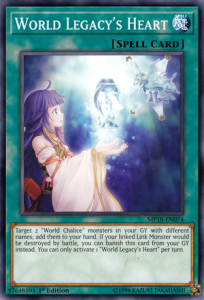 Lee the World Chalice Fairy – Having another WC can be helpful if you draw into either of your two ‘Garnets’, but this also serves as a way of getting dead cards out of your hand.
Lee the World Chalice Fairy – Having another WC can be helpful if you draw into either of your two ‘Garnets’, but this also serves as a way of getting dead cards out of your hand.- Orcust Brass Bombard – You might have seen this guy in my test duels for a good reason – this Orcust helps the deck out a ton while also being a Level 1 Tuner to combine with Draco for a Miko Synchro Summon. I ended up cutting him late in the process due to simply not using it enough.
- World Legacy – “World Shield” – Arguably the most questionable of WL monsters to run, since its effect will give your opponent a free monster (unless you give them Iblee first), but a recurring 3000 DEF wall that protects your WL cards is nothing to scoff at.
- World Legacy’s Heart – With more WC monsters like Lee, one could run this deck with less of another engine, and in that case, you would want to use this highly searchable option.
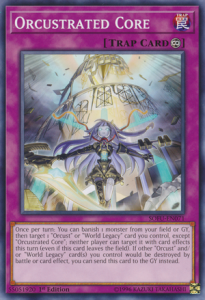 World Legacy’s Memory – Since Memory is a Quickplay spell, you can use it during your opponent’s turn to get to Purple, which then lets you get multiple resources for the following turn. But since it restricts you to Mekk-Knights only for the turn, it can get in the way of a hybrid build like this.
World Legacy’s Memory – Since Memory is a Quickplay spell, you can use it during your opponent’s turn to get to Purple, which then lets you get multiple resources for the following turn. But since it restricts you to Mekk-Knights only for the turn, it can get in the way of a hybrid build like this.- Orcustrated Core – Protection, plus it works on any WL cards.
- Orcustrated Einsatz – With the ability to mill any Orcust or Wand/Chalice/Shield during the opponent’s turn, this can be helpful in setting up your plays.
- World Legacy Landmark – A very unrestricted double reborn trap, and since it is so easily searched from the deck, one could justify using it as an extender.
- World Legacy Struggle – The only in-WLTheme backrow destruction that is worth considering outside of Phoenix. Yes, it is slow. But at minimum it is a +1 when you can resolve it.
- World Legacy Trap Globe – Since you burn through your deck so fast doing typical plays, you can choose to run Trap Globe to continue gaining more advantage after your combos are complete.
- World Legacy’s Secret – With more of a Mekk-Knight core, you could run this card to disrupt the opponent much better than most builds of the deck, so it is something to consider.
- Orcustrated Babel – Despite every WL theme having a Field Spell, I didn’t choose to run any of them, but the best to tech in is the ever-searchable Babel to keep doing Orcust things on both turns.
Non World Legacy Support Options:
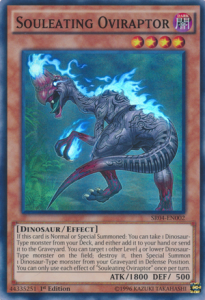 Dinosaur Engine: Souleating Oviraptor, Miscellaneousaurus, Dinowrestler Pankratops, Fossil Dig & Jurrac Aeolo – If you want to deviate from any of the WL themes, this is the first place to start. Since Oviraptor can Miscellaneous, you can use Misc’s effect to summon Aeolo from deck and go directly into a Miko. This is a great combo starter, and the additional benefits of running other Dino support cards like Pankraptops (Unique type/Attribute combo for summoning Regalia) can be a great engine to support a WL core.
Dinosaur Engine: Souleating Oviraptor, Miscellaneousaurus, Dinowrestler Pankratops, Fossil Dig & Jurrac Aeolo – If you want to deviate from any of the WL themes, this is the first place to start. Since Oviraptor can Miscellaneous, you can use Misc’s effect to summon Aeolo from deck and go directly into a Miko. This is a great combo starter, and the additional benefits of running other Dino support cards like Pankraptops (Unique type/Attribute combo for summoning Regalia) can be a great engine to support a WL core.- Cyberse Engine: Formud Skipper, Cyberse White Hat, Draconnet, Cyberse Gadget, Cynet Mining – Similar to the last build, except this engine would be more focused around a WL build with a WC core. With the innate connection of Cyberse monsters to Normal monsters, it is easy to go Draconnet into Crowned into Miko, plus Formud gives you access to a one-card Mermaid if you don’t draw Iblee. And since Cynet Mining will search any lower level Cyberse, it’s definitely an option to consider, a great parallel to the Dino engine.
- Red-Eyes Darkness Metal Dragon – Everyone knows what this thing does with the Guardragons. So you can always consider running a build featuring REDMD and a couple other dragons as an extender engine.
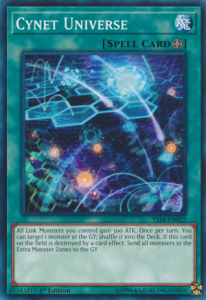 Cynet Universe – As noted before, I don’t run the other WL Field Spells, so you could consider running this anti-garnet option. It’s great at getting the cards you need back to deck, even if it does come with a potential downside.
Cynet Universe – As noted before, I don’t run the other WL Field Spells, so you could consider running this anti-garnet option. It’s great at getting the cards you need back to deck, even if it does come with a potential downside.- Foolish Burial Goods – WL Mind Meld wants to be in the GY, and Orcustrated Climax can also function from there. So why not consider the Goods as well?
- Unexpected Dai – Since you are running multiple Normal monsters, you can easily add in a couple Unexpected to act as a playstarter and to get more Link material from the getgo.
- Rescue Ferret – With so many Link Arrows available to the deck, this card can be an interesting tech to pull whatever you need for the situation out of the deck. This idea definitely would need some further refining though before you jump into a variant.
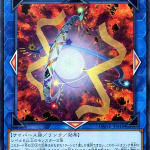
Conclusion:
At the end of the day, the World Legacy archetype is the opposite of Zefra. Instead of being supported by other themes, it inherently supports and provides the glue to hold multiple diverse themes together. And at the end of the day, if you want to determine the next creative deck, you need to take some liberties and try to figure out what works. Sure, this build may seem like I threw everything together haphazardly, but that is definitely not the case if you start dueling with the build. Hopefully this article might inspire you to try something new with an archetype you love – or refine those deckbuilding skills to identify which cards might be able to combo together into a long string of plays. Thanks for reading!
Do you think you have what it takes to contribute articles to our site? Check out our recent Community Collab initiative – you could be a co-writer on our next strategy article! For more information, check out the article linked through the banner below, then if you are interested, feel free to private message me on the YGOrg Discord server. I look forward to working on some cool articles with some of you!

